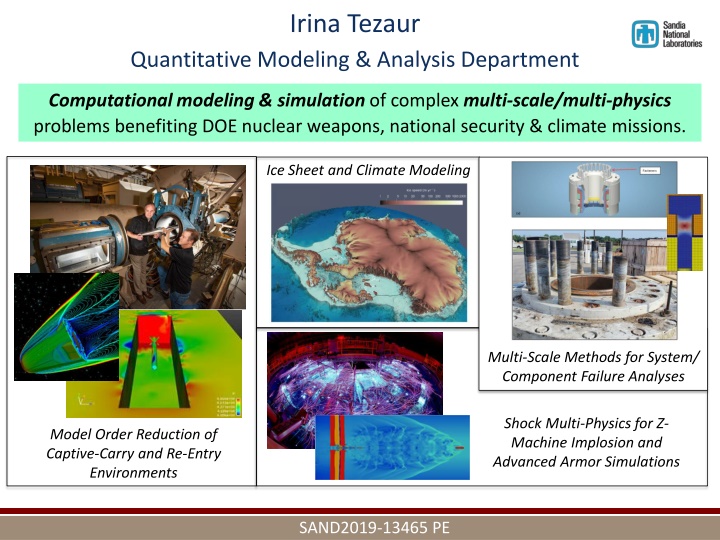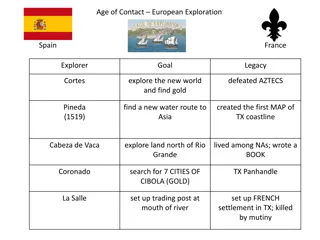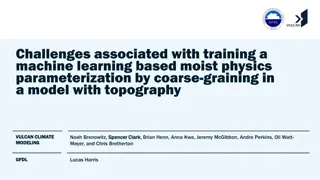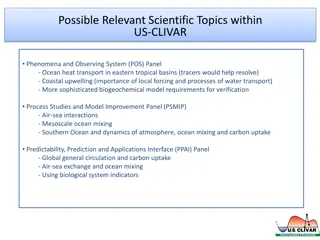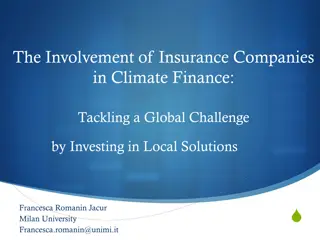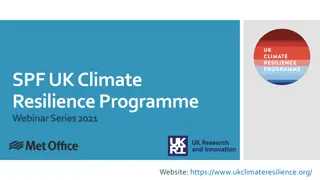Advancing Computational Modeling for National Security and Climate Missions
Irina Tezaur leads the Quantitative Modeling & Analysis Department, focusing on computational modeling and simulation of complex multi-scale, multi-physics problems. Her work benefits DOE nuclear weapons, national security, and climate missions. By employing innovative techniques like model order reduction and multi-scale methods, Irina's research enables real-time design quantification and uncertainty quantification, complementing experimental work. She also works on ice sheet and climate modeling to predict sea-level rise and support national security missions. Using data-driven approaches and simulations, her team explores diverse scenarios to inform decision-making. Computational modeling and simulation play a crucial role in enhancing engineering designs and predicting future scenarios across various domains.
Uploaded on Sep 16, 2024 | 4 Views
Download Presentation

Please find below an Image/Link to download the presentation.
The content on the website is provided AS IS for your information and personal use only. It may not be sold, licensed, or shared on other websites without obtaining consent from the author.If you encounter any issues during the download, it is possible that the publisher has removed the file from their server.
You are allowed to download the files provided on this website for personal or commercial use, subject to the condition that they are used lawfully. All files are the property of their respective owners.
The content on the website is provided AS IS for your information and personal use only. It may not be sold, licensed, or shared on other websites without obtaining consent from the author.
E N D
Presentation Transcript
Irina Tezaur Quantitative Modeling & Analysis Department Computational modeling & simulation of complex multi-scale/multi-physics problems benefiting DOE nuclear weapons, national security & climate missions. Ice Sheet and Climate Modeling Multi-Scale Methods for System/ Component Failure Analyses Shock Multi-Physics for Z- Machine Implosion and Advanced Armor Simulations Model Order Reduction of Captive-Carry and Re-Entry Environments SAND2019-13465 PE
Computational Modeling & Simulation Computational/mathematical modeling & simulation can replaceand/or enhance laboratory/field experiments, which can be costly and time- consuming. It allows one to explore and evaluate multiple configuration settings for engineering designs, and predict possible future scenarios of interest worldwide (e.g., disease outbreaks, climate change). Computer simulations can provide actionable information to support public policy and decision making. Image from SNL s Center for Computing Research (CCR) homepage
Model Order Reduction of the Captive-Carry and Re-Entry Environments Data-driven approach that speeds up simulations, which can take weeks even when run on massively parallel supercomputers Enables real-time design quantification and uncertainty quantification Complements experimental workperformed in Sandia s wind tunnels.
Multi-Scale Methods for System/Component Failure Analyses Small-scaledefects can lead to large-scale structural failure (left). Roof failure of Boeing 737 aircraft due to fatigue cracks. Simulating multiple scales is very challenging! Plug-and-play multi-scale simulation framework reduces simulation time from months to weeks and enables exploration of many failure scenarios. Components held together by fasteners
Ice Sheet & Climate Modeling Most likely SLR by 2100: 0.8-1m (2014 IPCC AR) Motivation: 2007 IPCC AR declined to include estimates of future sea-level rise from ice sheet dynamics due to deficiencies in ice sheet models. We are developing a next-generation ice model that will provide actionable predictions of 21st century sea-level rise and supports national security missions as part of DOE Energy Exascale Earth System Model (E3SM). Related work involves detecting Arctic tipping points due to climate change using the E3SM and data-driven (machine-learned) models.
